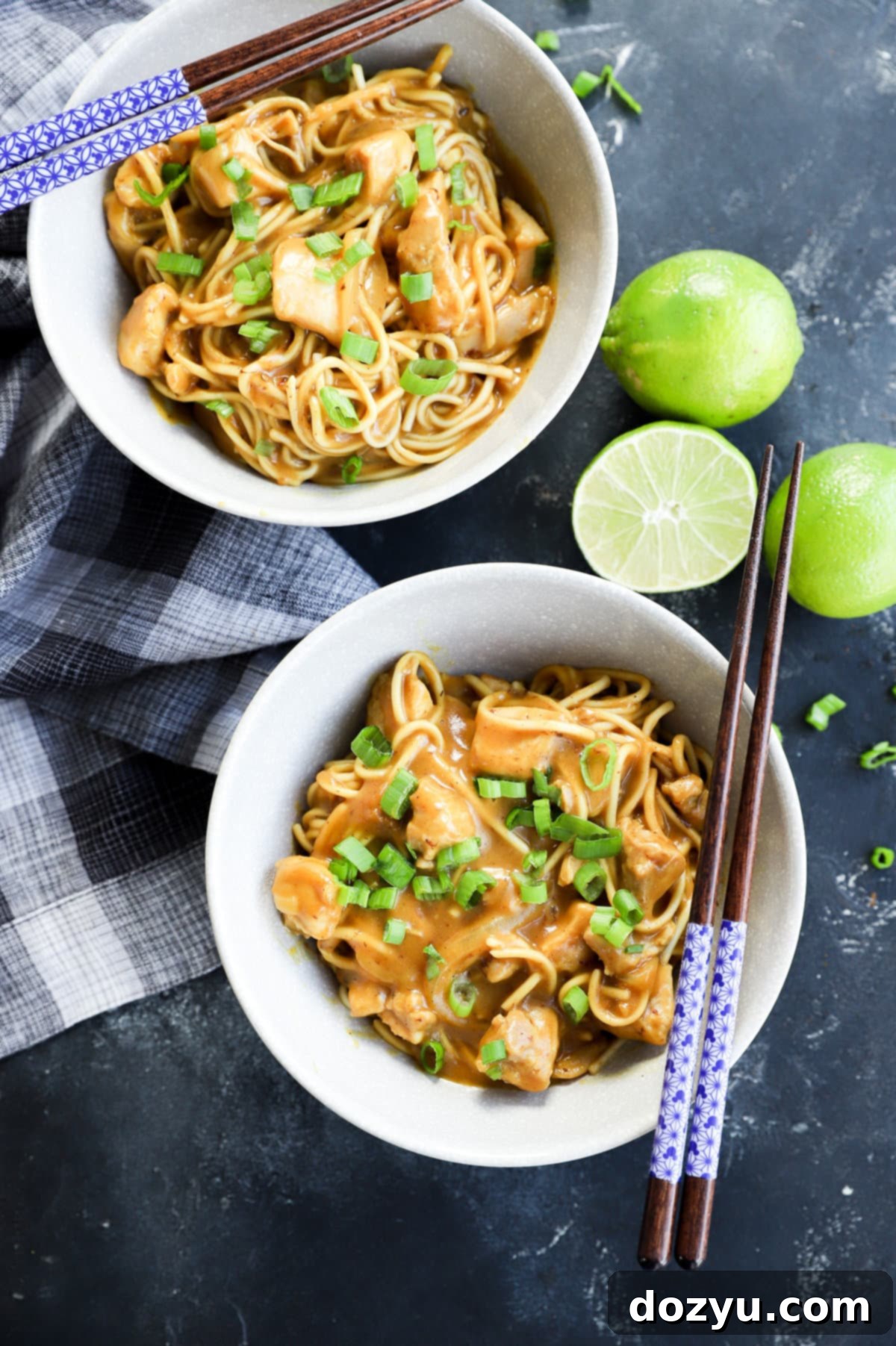Hearty & Easy Chicken Curry Udon: Your Perfect Weeknight Japanese Comfort Meal
Welcome to our go-to recipe for a comforting bowl of Curry Udon, expertly crafted for those busy weeknights when you crave something truly satisfying yet simple to prepare. This Japanese classic combines robust, aromatic curry flavors with thick, chewy udon noodles and tender chicken, creating a meal that’s both hearty and incredibly delightful. With just a handful of staple ingredients and minimal prep time, you’ll have a wholesome dinner that everyone in the family will adore. One of the best parts? You can easily customize the consistency of your curry, whether you prefer a rich, thick sauce generously coating your noodles or a lighter, savory broth in which your udon gracefully swims. Get ready to experience the warmth and depth of Japanese comfort food right in your own kitchen!
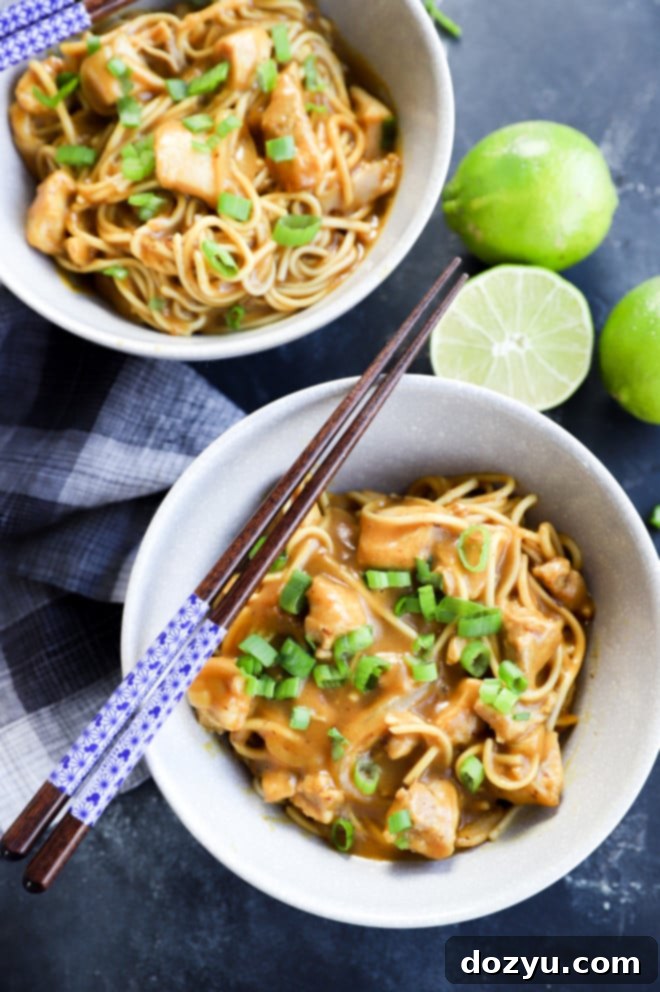
Table of Contents
About This Curry Udon Recipe
Japanese curry udon is more than just a meal; it’s an experience of deep comfort and rich flavor, especially perfect for unwinding after a long day or on a cool evening. This dish features a captivating blend of savory, slightly sweet, and mildly spicy curry, which can be tailored to your preferred consistency, either as a lush, thick sauce or a lighter, fragrant broth. Paired with wonderfully chewy udon noodles and succulent boneless, skinless chicken thighs, it creates a perfectly balanced and incredibly filling one-pot meal.
Our simplified take on this classic Japanese dish makes it approachable for home cooks of all skill levels, even those new to Asian cuisine. You’ll love how easily it comes together, and the ability to customize ingredients and consistency ensures it will become a regular favorite. The interplay of textures – the tender chicken, the soft yet firm udon, and the velvety curry – is truly a delight for the senses. It’s a substantial, flavorful meal that the entire family will look forward to, proving that delicious and authentic-tasting dishes don’t have to be complicated.
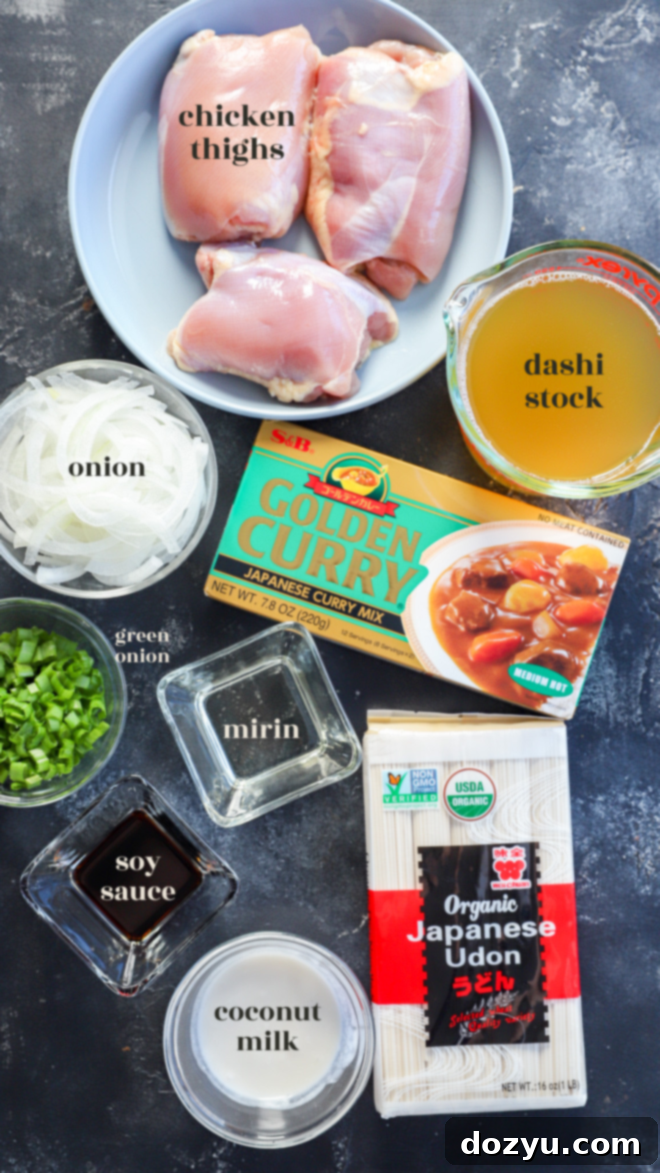
Key Ingredients for Curry Udon
This Japanese curry udon recipe relies on a few key ingredients to create its signature rich and savory profile. Here’s a closer look at what you’ll need:
- Oil: A neutral cooking oil like canola, vegetable, or even a light olive oil works perfectly for sautéing. It provides the base for browning your chicken and softening your onions, building foundational flavors.
- Chicken: Boneless, skinless chicken thighs are highly recommended for their tenderness and ability to stay juicy even when simmered in the curry sauce. They absorb the flavors beautifully. If preferred, boneless, skinless chicken breast can be used, but cook it carefully to avoid drying out.
- Onion: Sliced white or yellow onion adds a subtle sweetness and aromatic depth to the curry base. When cooked until translucent, they melt into the sauce, contributing to its overall richness.
- Udon Noodles: These thick, chewy wheat noodles are the star of the dish. You have several options:
- Fresh Udon: Often found in the refrigerated section of Asian markets, these cook quickly and have a wonderfully soft, bouncy texture.
- Frozen Udon: A fantastic option, often considered the closest in texture to fresh. They cook in just a few minutes directly from frozen.
- Dried Udon: A pantry staple, these are convenient and easy to store. Just follow package instructions for cooking, keeping in mind they may have a slightly firmer chew.
- Homemade Udon: For the adventurous cook, making udon from scratch offers unparalleled freshness and texture.
No matter which type you choose, ensure you follow the cooking instructions carefully, often undercooking them slightly as they will finish cooking in the hot curry sauce.
- Dashi Stock: This is the fundamental Japanese broth that provides the deep umami flavor essential to many Japanese dishes, including curry udon. If authentic dashi stock is unavailable, you can substitute with quality chicken or vegetable stock for a still delicious, though slightly different, flavor profile.
- Mirin: A sweet Japanese rice wine, mirin adds a nuanced sweetness, depth, and a beautiful sheen to the sauce. It’s crucial for balancing the savory and spicy notes. If you can’t find mirin, dry white wine or rice wine vinegar can be used as a substitute, though they won’t offer the same sweetness.
- Soy Sauce: A cornerstone of Japanese cuisine, soy sauce contributes savory umami and necessary saltiness. Feel free to use low-sodium soy sauce if you are mindful of your sodium intake.
- Salt: A touch of kosher sea salt is used to fine-tune the overall seasoning of the curry.
- Japanese Curry Roux: For convenience and authentic flavor, Japanese curry roux cubes are highly recommended. Brands like S&B Golden Curry Sauce Mix are widely available and come in various spice levels. These cubes already contain a blend of spices, thickeners, and flavor enhancers, making a rich curry base effortlessly.
- Coconut Milk: Full-fat coconut milk adds a delightful creaminess and a hint of exotic sweetness that beautifully mellows the curry and contributes to a luxurious texture. It also helps to balance any spiciness.
- Garnish: Elevate your curry udon with fresh garnishes like thinly sliced green onions for a pop of color and mild oniony flavor. Lime wedges offer a bright, acidic counterpoint that cuts through the richness of the curry. Don’t hesitate to experiment with pickled ginger, shichimi togarashi (Japanese seven-spice blend), or a soft-boiled egg.
Essential Equipment for Curry Udon
To whip up this fantastic curry udon, you’ll need a few basic kitchen tools:
- Large Skillet or Dutch Oven: A spacious cast iron skillet or a deep skillet (like a risotto skillet) with high sides is ideal for browning the chicken and simmering the curry sauce. A Dutch oven also works wonderfully.
- Saucepan: Essential for boiling water to cook your udon noodles separately.
- Wooden Spoon or Spatula: Perfect for stirring, scraping up browned bits, and combining ingredients without damaging your nonstick surfaces.
- Measuring Cups and Spoons: For accurate ingredient measurements, ensuring consistent results every time.
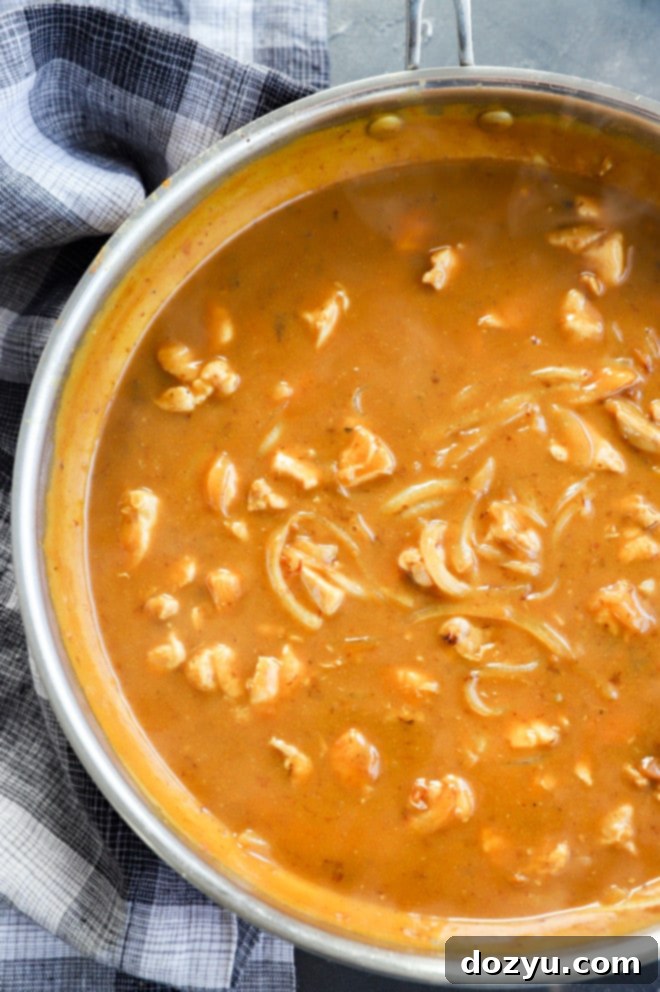
Step-by-Step Guide to Making Chicken Curry Udon
Follow these simple steps to create a delicious and authentic-tasting chicken curry udon:
Prepare Chicken and Onions
Begin by heating a tablespoon of your chosen oil in a large, deep skillet or Dutch oven over medium heat. Once the oil shimmers, add your boneless, skinless chicken thighs. Cook for approximately 5 to 6 minutes, turning occasionally, until the chicken is beautifully browned on all sides. Browning the chicken not only cooks it but also develops a rich, savory crust that adds depth to the overall dish. Remove the chicken from the pan and set it aside in a bowl.
Next, add your thinly sliced onions to the same skillet. Cook them, stirring frequently, for about 2 to 3 minutes until they become soft and translucent. The onions will absorb some of the residual chicken flavor, and their natural sweetness will begin to caramelize, enhancing the curry base. Once softened, transfer the onions to the bowl with the chicken.
While the chicken and onions are cooking, bring a separate saucepan of water to a rolling boil for your udon noodles.
Craft the Flavorful Curry Sauce
Using the same skillet (don’t clean it, those browned bits add flavor!), pour in the dashi stock. Immediately use a wooden spoon or spatula to scrape up all the flavorful browned bits (fond) from the bottom of the pan. This process, known as deglazing, incorporates all that delicious concentrated flavor into your sauce.
Stir in the mirin, soy sauce, and a pinch of salt. Then, add the Japanese curry roux cubes. Continue stirring consistently until the curry cubes are completely dissolved, ensuring a smooth, lump-free sauce base. Bring the mixture to a gentle simmer and let it cook for a few minutes, allowing the flavors to meld and the sauce to begin thickening slightly.
Cook the Udon Noodles
While your curry sauce is simmering, it’s time to cook the udon noodles. Add the noodles to the boiling water in your saucepan. Cook them for a few minutes less than the package instructions suggest – typically around 3 minutes. This slight undercooking is important because the noodles will finish cooking and absorb more flavor when added to the hot curry sauce, preventing them from becoming mushy. Once cooked al dente, drain the udon noodles thoroughly and set them aside.
Bring It All Together
After the curry sauce has simmered for a few minutes and started to thicken, return the cooked chicken and softened onions to the skillet. Stir gently to combine them with the sauce. Allow everything to simmer together for another 3 to 5 minutes. This step allows the chicken to absorb the rich curry flavors and ensures it’s fully heated through. During this time, you can also adjust the consistency of your sauce:
- To thicken the sauce: Continue simmering for a little longer, uncovered, to allow more liquid to evaporate.
- To thin the sauce: Stir in a bit more dashi stock (or chicken/vegetable stock) until it reaches your desired broth-like consistency.
Finally, stir in the cooked udon noodles and the coconut milk. Mix everything until the coconut milk is fully incorporated and the noodles are thoroughly coated and warmed through, which should take about a minute. The coconut milk will add a luxurious creaminess and subtly sweet undertone to the finished dish.
Serve your chicken curry udon immediately in large bowls, garnished generously with freshly sliced green onions. For an extra touch of brightness, a squeeze of fresh lime juice can make a world of difference!
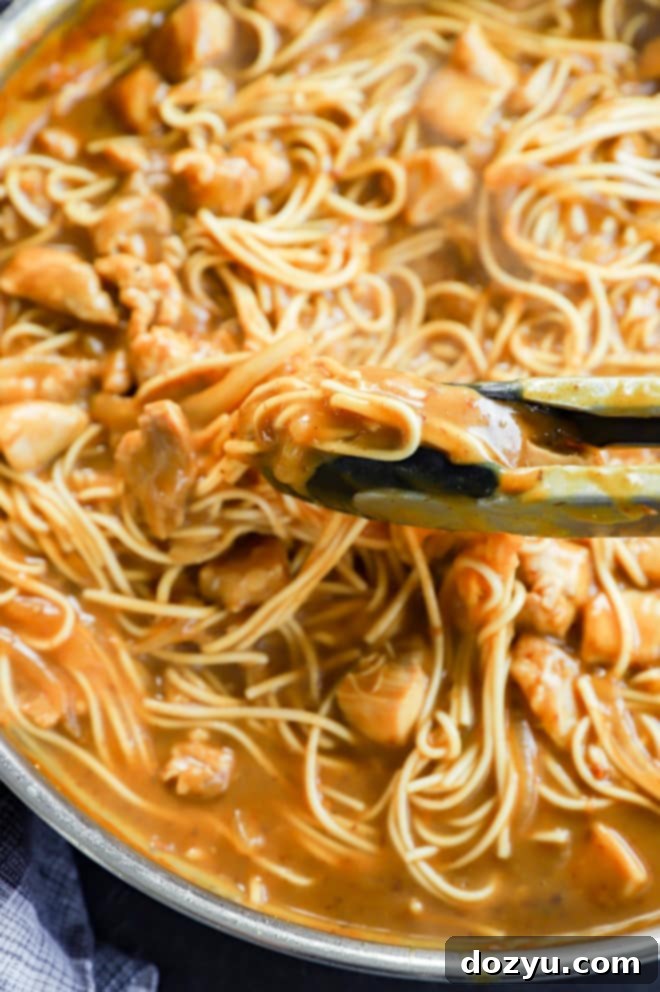
Pro Tips and Tricks for Perfect Curry Udon
Mastering your curry udon is all about personal preference and a few clever tricks. Here’s how you can make this dish truly your own:
- Customize the Consistency: The beauty of this recipe lies in its adaptability.
- For a thicker, richer sauce: Allow the curry to simmer longer, reducing the liquid until it reaches a hearty, gravy-like consistency that clings beautifully to the noodles. This is my personal favorite!
- For a thinner, soup-like broth: Cook the sauce for less time or simply stir in an additional splash of dashi stock (or your chosen substitute) until it achieves a comforting, slurpable broth.
- Amp Up the Spice: If you crave more heat, don’t hesitate to spice things up! Consider adding a drizzle of Sriracha or chili oil directly into your bowl. For a deeper, more integrated heat, a pinch of cayenne pepper or a dash of your favorite hot sauce can be stirred into the curry sauce during the simmering stage. Japanese shichimi togarashi (seven-spice blend) sprinkled on top also adds a wonderful complex heat and aroma.
- Add a Bright Acidic Touch: The richness of Japanese curry can be wonderfully balanced by a hint of acidity. Serving with fresh lime wedges allows each diner to squeeze a burst of zesty flavor over their bowl, cutting through the creaminess and elevating the overall taste. It’s a small addition that makes a big impact!
- Experiment with Proteins: While chicken thighs are fantastic, this recipe is incredibly versatile for other proteins:
- Pork: Sliced pork belly or pork shoulder can be browned and simmered similarly to chicken, adding a different depth of flavor.
- Beef: Thinly sliced beef (like sirloin or chuck) works well, especially if you prefer a heartier meat.
- Tofu or Tempeh: For a vegetarian or vegan option, firm or extra-firm tofu (pressed and cubed) or tempeh can be pan-fried until golden before being added to the curry.
- Sneak in More Vegetables: Boost the nutritional value and texture by adding more vegetables. Carrots, bell peppers, broccoli florets, snap peas, or mushrooms can be sautéed with the onions or added to the simmering curry sauce until tender-crisp. Fresh spinach or bok choy can be stirred in during the last minute of cooking until just wilted.
More yummy noodle recipes to try: Gochujang Noodles | Lemon Ricotta Pasta | Singapore Street Noodles | Farmers Market Pasta
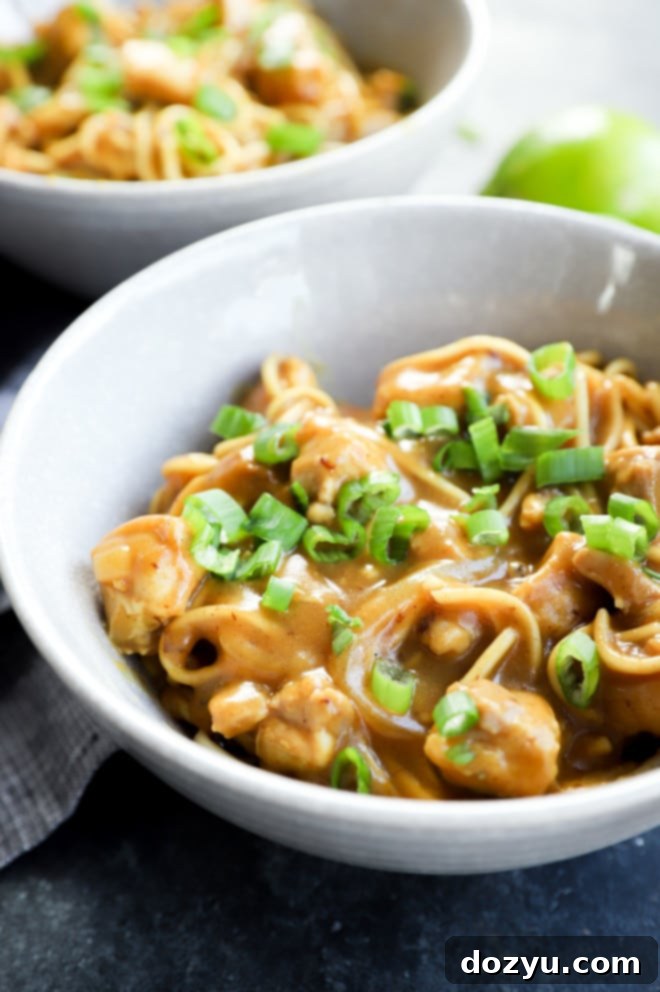
Curry Udon: Sauce vs. Broth Consistency Explained
One of the most appealing aspects of Japanese curry udon is its incredible flexibility, especially when it comes to the consistency of the curry itself. While some traditionalists might argue for a more broth-like, soupy texture, many modern preparations, and personal preferences lean towards a thicker, more sauce-like consistency. I personally adore a rich, velvety curry that generously coats each thick udon noodle and every piece of tender chicken. This creates an even more comforting and decadent mouthfeel that I find utterly irresistible.
However, if your preference is for a lighter, more brothy experience, achieving that is remarkably simple! You can easily adjust the consistency by simmering the sauce for a shorter duration, preventing too much liquid from evaporating. Then, gradually stir in extra dashi stock (or your chosen substitute like chicken or vegetable stock) until it reaches the desired level of thinness. This allows you to truly tailor the dish to your liking, making it a versatile staple in your recipe repertoire.
Choosing the Best Udon Noodles
Udon noodles, known for their distinctive thick and chewy texture, are available in several forms, each offering slightly different characteristics:
- Fresh Udon: These are often found in the refrigerated sections of Asian supermarkets. They boast the most tender and bouncy texture, cooking very quickly, often in just 1-2 minutes. They are fantastic if you can find them.
- Frozen Udon: Widely considered the best alternative to fresh, frozen udon noodles retain much of the fresh texture and chewiness. They cook directly from frozen in just a few minutes, making them incredibly convenient. They are an excellent choice for this recipe.
- Dried Udon: A convenient pantry staple, dried udon noodles are readily available in most grocery stores. While their texture can be slightly firmer than fresh or frozen, they are reliable and store well. Always follow the package instructions for cooking times.
- Homemade Udon: For the culinary enthusiast, making udon from scratch is a rewarding experience, yielding the freshest and most authentic texture possible.
I typically use either dried or fresh udon, depending on what’s available. For ease and convenience, I highly recommend keeping a pack of dry udon noodles in your pantry. This way, you can whip up this curry udon recipe on a whim without needing to plan a special trip to an Asian grocery store.
Making Vegetarian Curry Udon
Absolutely! This curry udon recipe can be easily adapted to be vegetarian or even vegan with a few simple substitutions. The core flavors of the curry roux and dashi are what truly define the dish, and these can be adjusted:
- Omit the Chicken: Simply leave out the chicken from the recipe.
- Vegetarian Protein Options:
- Tofu: Use firm or extra-firm tofu, pressed to remove excess water, then cubed and pan-fried until golden and slightly crispy. Add it to the curry alongside the onions or at the end.
- Tempeh: Similar to tofu, tempeh can be cubed and pan-fried for a heartier, nutty protein source.
- Mushrooms: Sliced cremini, shiitake, or oyster mushrooms add a wonderful umami depth and meaty texture. Sauté them with the onions until tender.
- Vegetable Medley: Instead of a meat substitute, you can load the curry with a variety of vegetables like broccoli, carrots, bell peppers, or snap peas.
- Dashi (for Vegan version): Ensure you use a vegetarian dashi stock. Look for kombu (seaweed) dashi or shiitake mushroom dashi, which are both plant-based. If using instant dashi, check the ingredients to confirm it’s vegetarian/vegan (some contain bonito flakes, which are fish-based). Alternatively, vegetable stock works well.
By making these adjustments, you can enjoy a delicious and satisfying vegetarian curry udon that’s just as flavorful as the original!
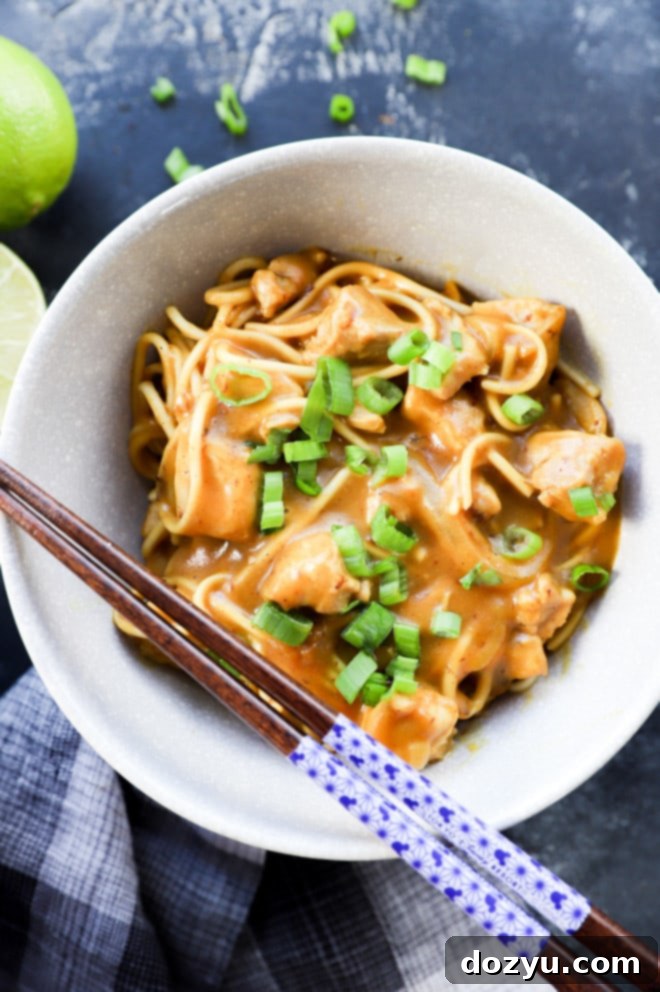
What is Mirin and its Role in Japanese Cuisine?
Mirin is a sweet Japanese rice wine that is a fundamental ingredient in Japanese cooking, highly valued for its ability to add depth, luster, and a unique sweetness to dishes. It’s similar to sake but with a lower alcohol content (typically around 14% for “hon mirin” or “true mirin”) and a significantly higher sugar content. This balance of sweetness and subtle acidity makes it indispensable in sauces, marinades, and glazes.
In this curry udon recipe, mirin plays several crucial roles:
- Flavor Depth: It contributes a complex, umami-rich sweetness that complements the savory soy sauce and aromatic curry, rounding out the flavor profile.
- Gloss and Sheen: Mirin helps create a beautiful, glossy finish on the sauce, making the dish visually appealing and giving it a rich texture.
- Odor Masking: It can also help mask strong odors from certain ingredients, like fish or meat, making the overall aroma more pleasant.
You can typically find mirin in the Asian section of most well-stocked grocery stores or online. If you are unable to locate “hon mirin” (true mirin), you might find “ajimirin” or mirin-fu chomiryo, which are mirin-like seasonings with less alcohol. As a last resort, dry white wine or rice wine vinegar with a pinch of sugar can serve as a substitute, though they won’t replicate mirin’s exact flavor and complexity.
Understanding Dashi: The Heart of Japanese Flavor
Dashi is a clear, flavorful broth that forms the backbone of countless Japanese dishes, providing the essential umami taste that characterizes much of Japanese cuisine. It’s not just a broth; it’s a flavor enhancer that brings out the natural taste of other ingredients without overpowering them. The most common types of dashi include:
- Katsuobushi Dashi: Made from dried, smoked bonito flakes, giving it a rich, savory, slightly smoky flavor.
- Kombu Dashi: Made from dried kelp (seaweed), offering a more subtle, delicate, and deeply umami flavor, often used in vegetarian dishes.
- Awase Dashi: A combination of katsuobushi and kombu, yielding a balanced and complex flavor.
- Shiitake Dashi: Made from dried shiitake mushrooms, providing a distinct earthy umami, perfect for vegetarian or vegan recipes.
While you might find ready-made liquid dashi stock in local Asian grocery stores, it’s very common and easy to make your own using instant dashi powder or granules. Simply dissolve the powder in hot water according to package directions to create a fresh batch of dashi in minutes. This is a staple to keep in your pantry if you enjoy Japanese cooking regularly.
Selecting the Right Japanese Curry Roux
For achieving that authentic, rich, and comforting Japanese curry flavor with ease, pre-made Japanese curry roux blocks are your best friend. These convenient cubes contain a blend of curry powder, flour (as a thickener), oils, and other spices and seasonings, ensuring consistent flavor and a perfect texture every time.
I personally love using S&B Golden Curry Sauce Mix. It’s widely available, including on Amazon, and comes in various spice levels (mild, medium hot, hot, extra hot) so you can choose according to your preference. Other popular brands like Vermont Curry or House Foods also offer excellent options.
While you *could* attempt to make a curry base from scratch using curry powder and a cornstarch slurry, it’s important to note that it won’t yield the same complex depth of flavor or the characteristic velvety richness that Japanese curry roux blocks provide. These blocks are formulated to deliver that specific, comforting taste we associate with Japanese curry udon.
Dashi Substitutes: When You Can’t Find It
While dashi is highly recommended for its authentic umami profile, if you find yourself unable to source it, don’t let that stop you from making this delicious curry udon! You have excellent substitution options:
- Chicken Stock: A good quality chicken stock or broth is a readily available and effective substitute. It will provide a savory base that works well with the chicken and curry flavors.
- Vegetable Stock: For a vegetarian version or simply if you prefer, vegetable stock can be used. Ensure it’s a flavorful stock to contribute enough depth to the curry.
Pro Tip: If you’re using chicken or vegetable stock and want to infuse a subtle hint of umami, try adding a small piece of kombu (dried kelp) to the stock as it heats, then remove it before adding it to the curry. This can mimic some of dashi’s unique qualities.
Need more inspiration for dinner this week? Check out my main dishes recipe page!
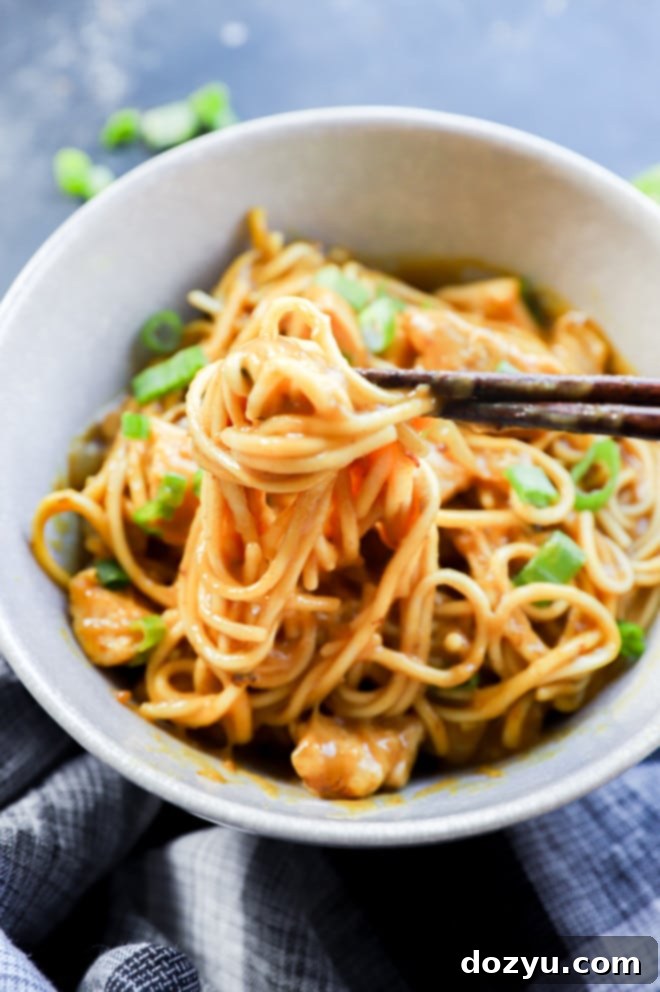
Serving Suggestions: What to Eat with Curry Udon
Curry udon is a wonderfully complete meal on its own, packed with protein, carbs, and vegetables (if you choose to add them). However, a few simple additions can elevate the experience and add extra layers of flavor and texture:
- Garnishes Galore: Beyond the essential green onions and lime wedges, consider sprinkling a pinch of shichimi togarashi (Japanese seven-spice blend) for a mild kick, or toasted sesame seeds for a nutty crunch.
- Add an Egg: A soft-boiled, poached, or fried egg placed on top is a classic addition. The runny yolk adds an extra layer of richness to the curry.
- Pickled Vegetables: Japanese pickled vegetables like daikon (takuan) or red ginger (beni shoga) offer a tangy, refreshing counterpoint to the rich curry. Their crunch and acidity cleanse the palate beautifully.
- Fresh Vegetables: Stir in fresh baby spinach or thinly sliced napa cabbage during the last minute of cooking until just wilted for added greens.
- Simple Side Salad: If you’d like a lighter accompaniment, a small side salad with a simple vinaigrette can be a refreshing contrast.
- Drink Pairing: For a delightful beverage pairing, consider a crisp and refreshing Japanese highball. Its effervescence and light flavor complement the rich curry without overpowering it.
Storage and Reheating Tips for Leftover Curry Udon
If you happen to have any leftover curry udon (a rare occurrence, it’s that good!), here’s how to properly store and reheat it to maintain its deliciousness:
- Storing: Allow the curry udon to cool completely before transferring it to an airtight container. Store it in the refrigerator for up to 3 days. It’s best to store the noodles and sauce separately if possible, though often they are already combined.
- Reheating:
- Stovetop: The best method for reheating. Transfer the curry udon to a saucepan over medium-low heat. The sauce may have thickened further in the fridge, so add a splash of dashi stock or water to loosen it up and “give it new life.” Stir gently until warmed through.
- Microwave: For a quicker option, reheat individual portions in the microwave on medium power, stirring occasionally, until hot. Again, a little liquid may be needed to adjust the sauce consistency.
- Freezing: I do not recommend freezing this specific recipe. The udon noodles, especially fresh or frozen varieties, tend to become mushy and lose their desirable chewy texture after being frozen and thawed in the sauce. It’s best enjoyed fresh or within a few days from the refrigerator.
More Quick and Easy Weeknight Dinner Recipes
Looking for more delicious and easy meals to add to your weeknight rotation? Try these:
- Get your spicy fix with these creamy Kimchi Udon! You can easily bulk it up with your favorite protein.
- Bucatini Cacio e Pepe with Broccoli is creamy and made with super simple ingredients!
- Roasted Chicken with White Wine and Fresh Herbs is an easy way to make roasted chicken on a weeknight.
- Ready in just 20 minutes, Pasta Napolitana is the perfect dish of Italian noodles.
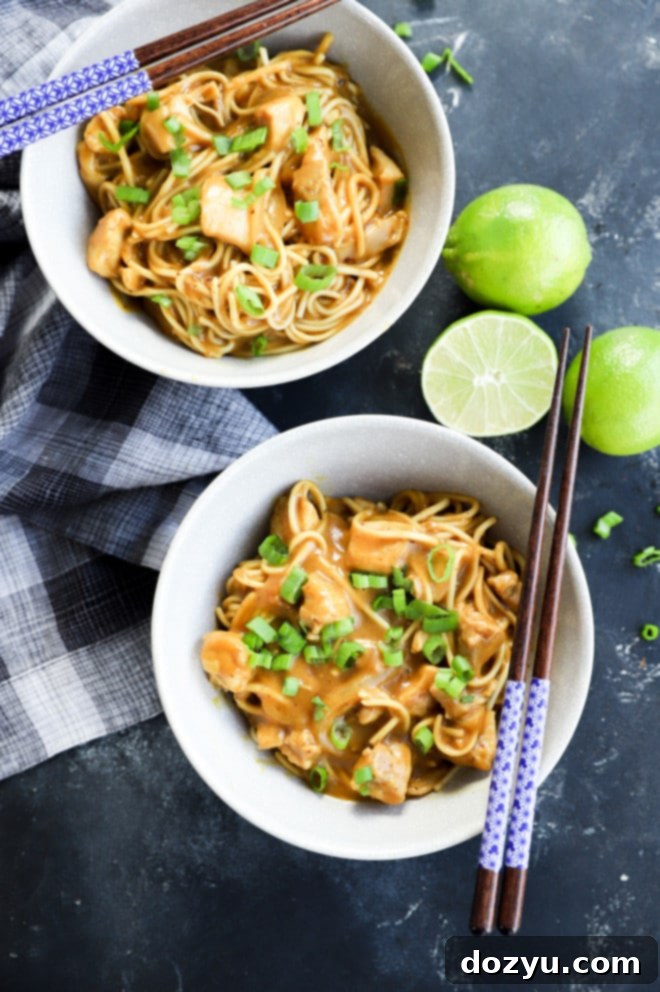
Finally, if you make this delightful chicken curry udon recipe, please be sure to give it a rating and/or leave a comment! I absolutely love hearing about your culinary adventures and take the time to respond to every single comment. Feel free to drop any questions you might have below too!
Oh, and don’t forget to tag me on Instagram if you share your creation! Seeing these recipes come to life in your homes is truly my favorite thing, and it genuinely means the world to me!
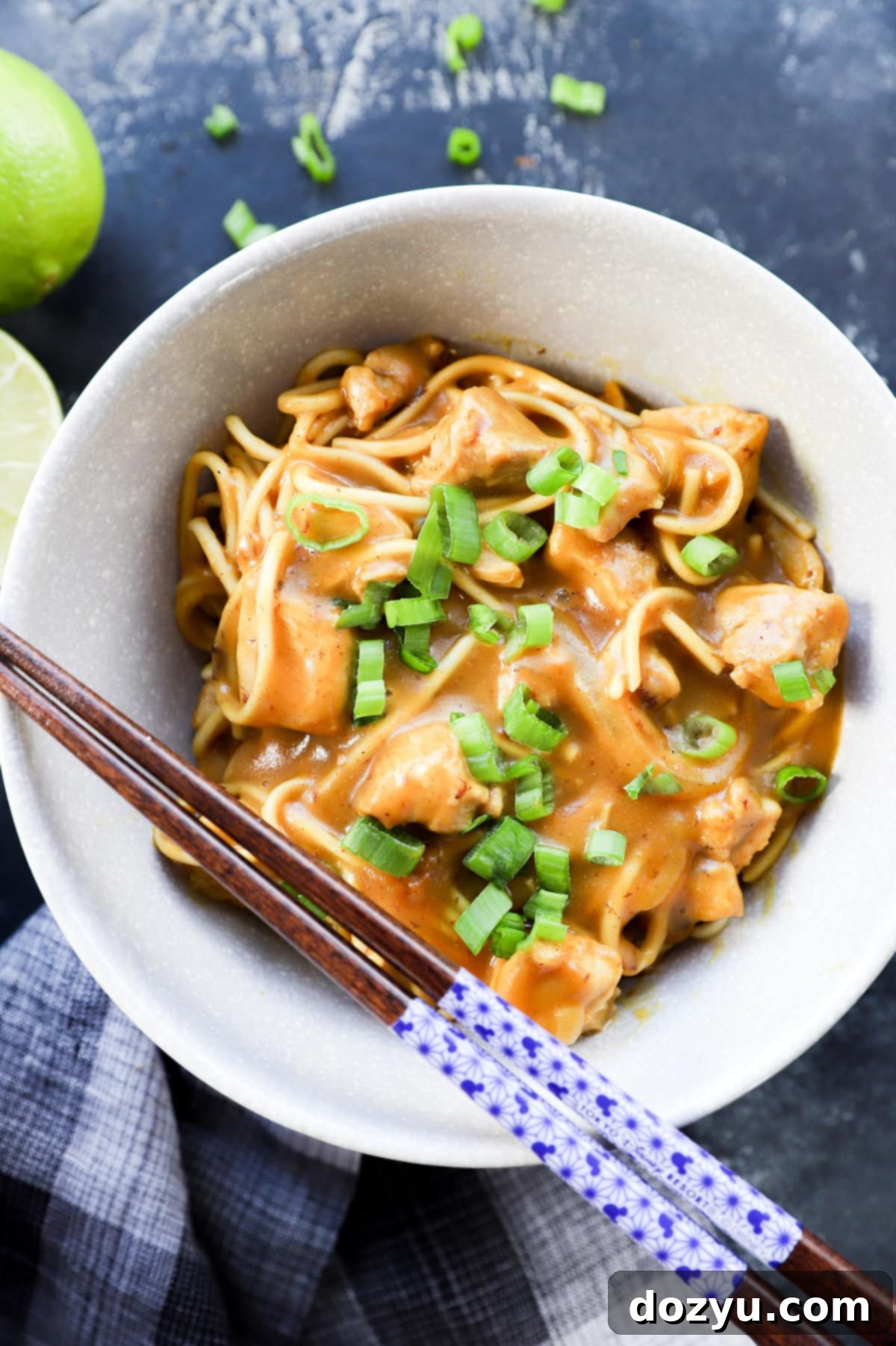
Curry Udon
Equipment
-
Utility Cutting Board
-
8-Inch Chef’s Knife
-
Saucepan
-
Nonstick 12-Inch Skillet with High Sides
-
Wooden Spoon
Ingredients
- 2 tsp canola oil (or vegetable/light olive oil)
- 1 lb boneless, skinless chicken thighs (about 2 to 3 chicken thighs, cut into bite-sized pieces)
- 1/2 yellow onion (thinly sliced)
- 3/4 lb to 1 lb udon noodles (fresh, frozen, or dried)
- 2 1/2 cups dashi stock (or vegetable/chicken stock)
- 2 Tbsp mirin
- 1 Tbsp soy sauce (use low sodium if preferred)
- 1/4 tsp kosher sea salt
- 1 pack Japanese curry roux (approx. 4 small cubes, e.g., S&B Golden Curry)
- 1/4 cup full-fat coconut milk
- Garnish: sliced green onion and lime wedges
Instructions
-
Bring a large pot of water to a boil and season with a pinch of salt.
-
While the water heats, warm the oil in a large skillet with high sides (or Dutch oven) over medium heat. Add the chicken and cook for 5 to 6 minutes, turning until well browned on all sides. Remove the chicken from the skillet and set aside.
-
Add the sliced onions to the same skillet. Cook, stirring occasionally, for 2 to 3 minutes until they are soft and translucent. Transfer the cooked onions to the bowl with the chicken.
-
Pour the dashi stock into the skillet. Use a wooden spoon to scrape up all the delicious browned bits from the bottom of the pan. Stir in the mirin, soy sauce, salt, and Japanese curry roux cubes. Continue stirring until the curry cubes are fully dissolved. Bring the mixture to a gentle simmer and cook for 2 to 3 minutes.
-
While the curry sauce is simmering, cook the udon noodles in the boiling water for about 3 minutes less than the package instructions. This ensures they’re slightly al dente. Drain well and set aside.
-
Return the browned chicken and softened onions to the skillet with the curry sauce. Stir gently to combine. Simmer for another 3 to 5 minutes, or until the sauce reaches your desired consistency (thicker if reduced longer, thinner if more dashi is added).
-
Add the cooked udon noodles and coconut milk to the skillet. Stir everything together until the coconut milk is fully incorporated and the noodles are thoroughly coated and warmed through, which should take about 1 minute.
-
Serve immediately in bowls, garnished generously with freshly sliced green onion and a lime wedge.
Video
Nutrition
Carbohydrates: 63g |
Protein: 38g |
Fat: 20g |
Saturated Fat: 8g |
Polyunsaturated Fat: 1g |
Monounsaturated Fat: 7g |
Trans Fat: 0.01g |
Cholesterol: 67mg |
Sodium: 2043mg |
Potassium: 597mg |
Fiber: 5g |
Sugar: 11g |
Vitamin A: 46IU |
Vitamin C: 1mg |
Calcium: 62mg |
Iron: 3mg
